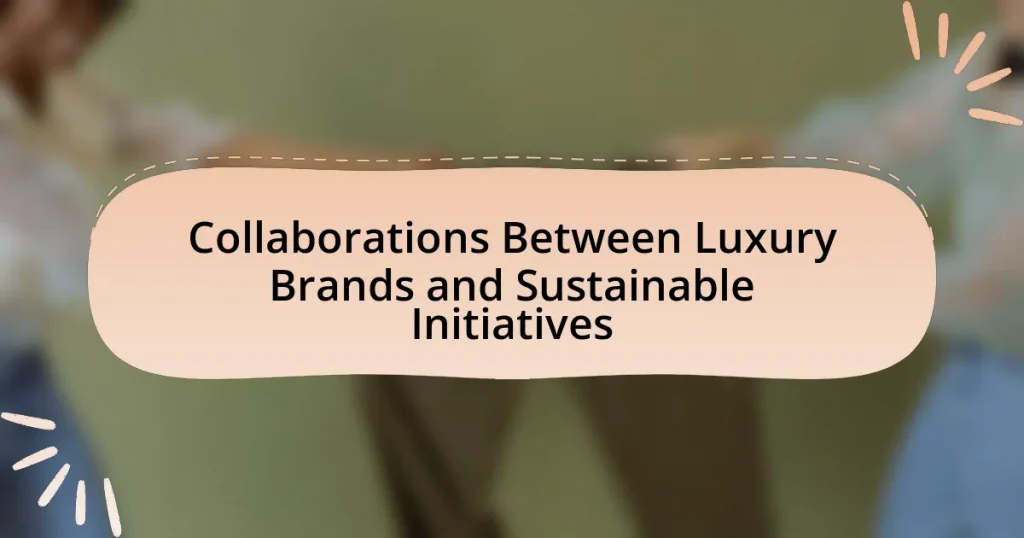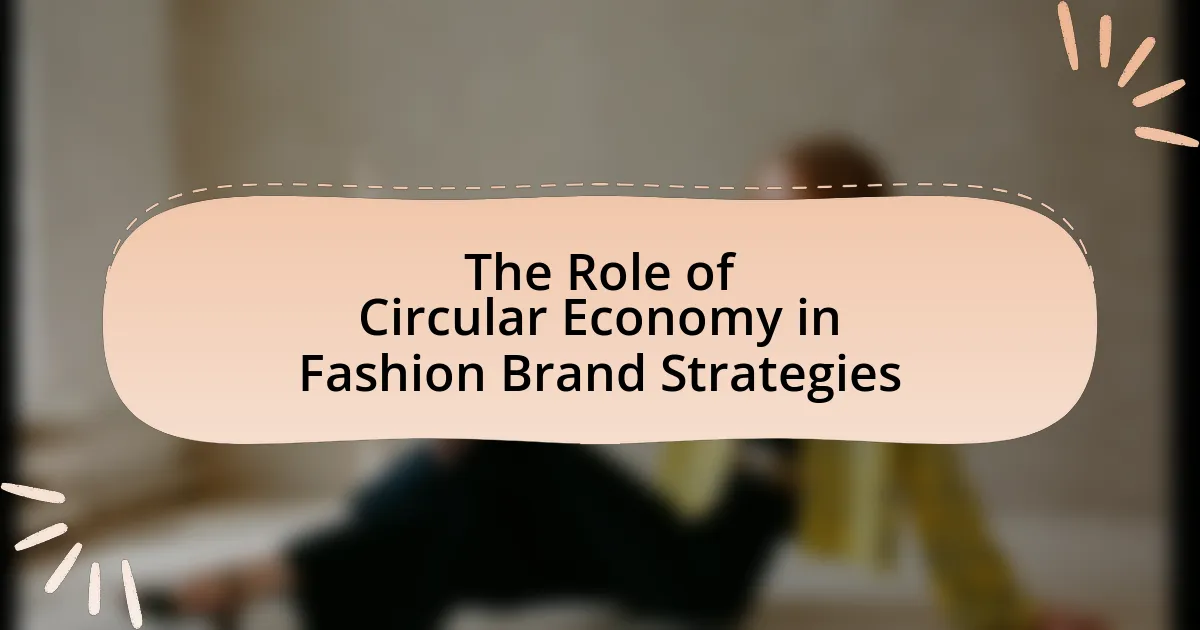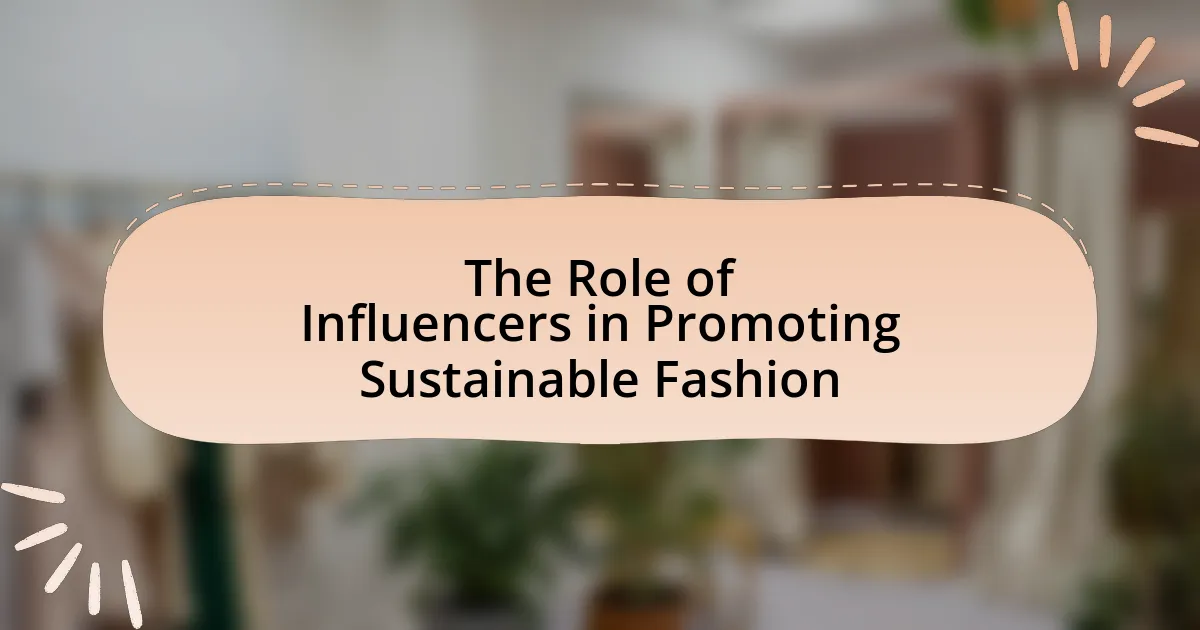Collaborations between luxury brands and sustainable initiatives focus on promoting environmental responsibility and ethical practices within the fashion sector. These partnerships lead to the creation of eco-friendly products, sustainable sourcing, and support for social causes, exemplified by brands like Stella McCartney and Gucci. The article explores how luxury brands define sustainability, the criteria for selecting partners, the importance of these collaborations in enhancing brand reputation, and their impact on consumer perception. Additionally, it addresses the challenges faced in these partnerships, successful examples, and future trends influenced by consumer expectations and technological advancements.
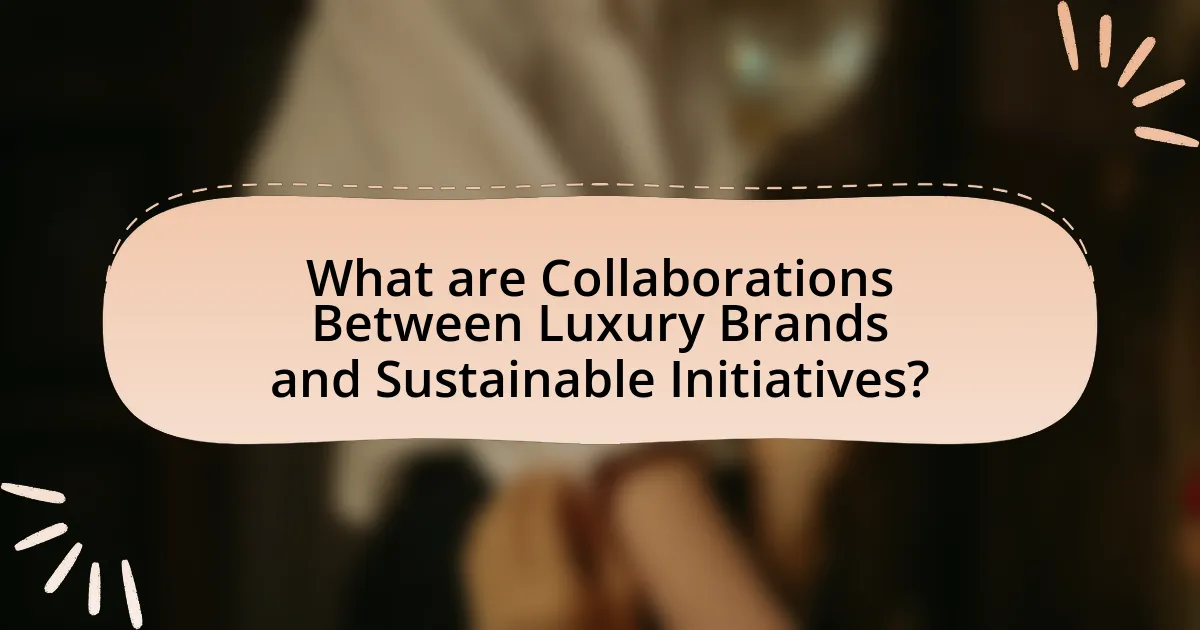
What are Collaborations Between Luxury Brands and Sustainable Initiatives?
Collaborations between luxury brands and sustainable initiatives involve partnerships aimed at promoting environmental responsibility and ethical practices within the fashion and luxury sectors. These collaborations often result in the development of eco-friendly products, sustainable sourcing of materials, and initiatives that support social causes. For instance, brands like Stella McCartney have partnered with organizations such as the Ellen MacArthur Foundation to promote circular fashion, emphasizing the importance of recycling and reducing waste. Additionally, luxury brands like Gucci have launched initiatives like the Gucci Equilibrium program, which focuses on sustainability and social impact, showcasing a commitment to reducing their carbon footprint and supporting local communities. These collaborations not only enhance brand reputation but also align with the growing consumer demand for sustainability in luxury goods.
How do luxury brands define sustainability in their collaborations?
Luxury brands define sustainability in their collaborations as a commitment to environmentally and socially responsible practices throughout the supply chain. This includes using eco-friendly materials, ensuring ethical labor practices, and minimizing carbon footprints. For example, brands like Stella McCartney prioritize sustainable sourcing and transparency, collaborating with organizations that promote circular fashion and waste reduction. Such initiatives are often backed by measurable goals, like reducing greenhouse gas emissions by a specific percentage within a set timeframe, demonstrating a concrete approach to sustainability in their partnerships.
What criteria do luxury brands use to select sustainable partners?
Luxury brands select sustainable partners based on criteria such as environmental impact, ethical practices, and alignment with brand values. These brands prioritize partners who demonstrate a commitment to reducing carbon footprints, utilizing sustainable materials, and ensuring fair labor practices. For instance, brands like Stella McCartney collaborate with suppliers who adhere to strict environmental standards and transparency in their supply chains, reinforcing their dedication to sustainability. This approach not only enhances brand reputation but also meets the growing consumer demand for responsible luxury.
How do these definitions impact the collaboration process?
Definitions of luxury and sustainability shape the collaboration process by establishing a common understanding and framework for partnership. When luxury brands define sustainability in specific terms, it influences their strategic goals, resource allocation, and marketing approaches, ensuring alignment with sustainable initiatives. For instance, a luxury brand that prioritizes eco-friendly materials will seek partnerships with suppliers who meet those standards, thereby streamlining the collaboration process. This alignment fosters trust and facilitates effective communication, as all parties share a clear vision and objectives. Research indicates that successful collaborations often hinge on shared definitions, which enhance synergy and drive innovation in sustainable practices within the luxury sector.
Why are collaborations between luxury brands and sustainable initiatives important?
Collaborations between luxury brands and sustainable initiatives are important because they enhance brand reputation while promoting environmental responsibility. Luxury brands, known for their influence and consumer loyalty, can drive significant change by integrating sustainable practices into their business models. For instance, a study by McKinsey & Company found that 66% of consumers are willing to pay more for sustainable brands, indicating a market demand for eco-friendly luxury products. This collaboration not only meets consumer expectations but also helps luxury brands differentiate themselves in a competitive market, ultimately contributing to a more sustainable future.
What role do these collaborations play in consumer perception?
Collaborations between luxury brands and sustainable initiatives significantly enhance consumer perception by aligning brand values with growing environmental consciousness. These partnerships signal to consumers that luxury brands are committed to sustainability, which can increase brand loyalty and attract environmentally aware customers. For instance, a study by Nielsen found that 66% of global consumers are willing to pay more for sustainable brands, indicating that such collaborations can positively influence purchasing decisions. Additionally, luxury brands that engage in sustainability initiatives often experience improved brand image and reputation, as consumers increasingly favor brands that demonstrate social responsibility.
How do they contribute to the overall sustainability movement?
Collaborations between luxury brands and sustainable initiatives contribute to the overall sustainability movement by promoting eco-friendly practices and raising awareness about environmental issues. These partnerships often lead to the development of sustainable materials, such as organic cotton or recycled fabrics, which reduce the environmental impact of production. For instance, luxury brands like Stella McCartney have pioneered the use of sustainable materials in their collections, demonstrating that high fashion can align with ecological responsibility. Additionally, these collaborations often involve initiatives that support fair trade and ethical labor practices, further enhancing their positive impact on society and the environment. By leveraging their influence, luxury brands can inspire consumers to adopt more sustainable lifestyles, thereby amplifying the reach and effectiveness of sustainability efforts.
What challenges do luxury brands face in these collaborations?
Luxury brands face several challenges in collaborations with sustainable initiatives, primarily related to brand alignment and consumer perception. Ensuring that the values and practices of the sustainable partner align with the luxury brand’s image is crucial; misalignment can lead to consumer skepticism and damage brand reputation. For instance, luxury consumers often prioritize exclusivity and heritage, which may conflict with the more accessible nature of some sustainable initiatives. Additionally, luxury brands must navigate the complexities of supply chain transparency and ethical sourcing, as any lapses can result in public backlash. According to a 2021 report by McKinsey & Company, 66% of consumers expect brands to take a stand on social and environmental issues, highlighting the importance of authenticity in these collaborations.
How do differing brand values affect collaboration outcomes?
Differing brand values significantly impact collaboration outcomes by influencing alignment, trust, and shared objectives. When luxury brands prioritize exclusivity and high profit margins, while sustainable initiatives focus on environmental responsibility and social equity, misalignment can lead to conflicts in goals and messaging. For instance, a study by the Harvard Business Review found that collaborations with aligned values resulted in a 30% increase in project success rates, highlighting the importance of shared principles. Therefore, when brand values diverge, the potential for effective collaboration diminishes, often resulting in ineffective partnerships and unmet expectations.
What are the common pitfalls in luxury and sustainability partnerships?
Common pitfalls in luxury and sustainability partnerships include misalignment of brand values, lack of transparency, and insufficient consumer engagement. Misalignment occurs when luxury brands prioritize profit over genuine sustainability efforts, leading to skepticism among consumers. Lack of transparency can result in greenwashing, where brands falsely claim sustainable practices without substantiation, damaging credibility. Insufficient consumer engagement means that brands fail to communicate their sustainability initiatives effectively, leading to a disconnect with their audience. These pitfalls can undermine the effectiveness of partnerships and hinder the overall impact on sustainability goals.
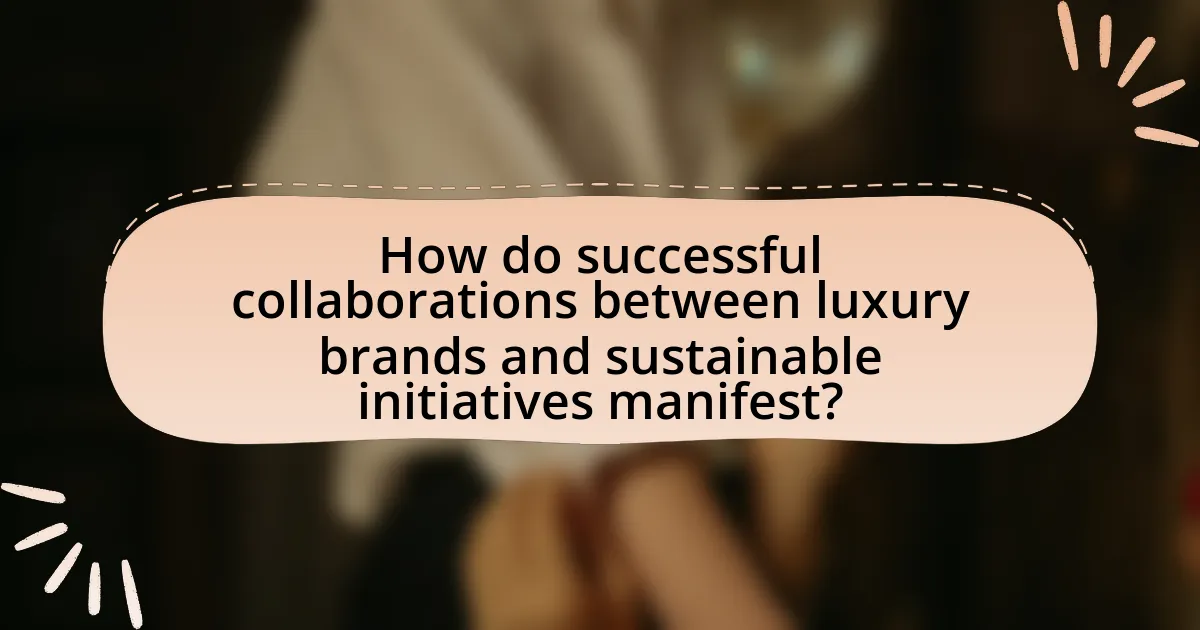
How do successful collaborations between luxury brands and sustainable initiatives manifest?
Successful collaborations between luxury brands and sustainable initiatives manifest through the integration of eco-friendly practices into product development and marketing strategies. For instance, luxury brands like Stella McCartney have partnered with organizations such as the World Wildlife Fund to promote sustainable sourcing of materials, demonstrating a commitment to environmental responsibility. These collaborations often result in limited-edition collections that highlight sustainable materials, such as organic cotton or recycled fabrics, appealing to environmentally conscious consumers. Additionally, partnerships with sustainability-focused influencers and campaigns raise awareness and enhance brand reputation, as seen with Gucci’s collaboration with the UN’s Fashion Industry Charter for Climate Action, which aims to reduce the fashion industry’s carbon footprint. Such initiatives not only drive sales but also foster a positive brand image aligned with contemporary consumer values.
What are some notable examples of successful collaborations?
Notable examples of successful collaborations between luxury brands and sustainable initiatives include the partnership between Stella McCartney and the environmental organization Parley for the Oceans, which focuses on creating fashion from recycled ocean plastic. Another example is the collaboration between Gucci and The RealReal, promoting circular fashion by encouraging the resale of luxury items. Additionally, the partnership between Prada and the non-profit organization Re-Nylon aims to produce bags made from recycled nylon, showcasing a commitment to sustainability. These collaborations demonstrate how luxury brands can effectively integrate sustainable practices into their business models.
How did these collaborations achieve their sustainability goals?
Collaborations between luxury brands and sustainable initiatives achieved their sustainability goals by integrating eco-friendly practices into their supply chains and product offerings. For instance, brands like Stella McCartney partnered with organizations such as the Ellen MacArthur Foundation to promote circular fashion, which emphasizes recycling and reducing waste. These collaborations often involve adopting sustainable materials, such as organic cotton or recycled polyester, which significantly lower environmental impact. Additionally, luxury brands have committed to transparency in sourcing and production processes, as seen in the Fashion Pact, which includes over 60 companies aiming to reduce their carbon footprint and promote biodiversity. These strategic partnerships not only enhance brand reputation but also drive industry-wide change towards sustainability.
What lessons can be learned from these successful partnerships?
Successful partnerships between luxury brands and sustainable initiatives demonstrate the importance of aligning values and goals for mutual benefit. These collaborations teach that integrating sustainability into brand identity can enhance consumer loyalty, as evidenced by the rise in sales for brands like Stella McCartney, which reported a 20% increase in revenue after emphasizing eco-friendly practices. Additionally, these partnerships highlight the effectiveness of shared resources and expertise, allowing brands to innovate sustainably while reducing costs. For instance, the collaboration between Gucci and The RealReal not only promotes circular fashion but also expands market reach, illustrating that sustainability can drive business growth.
How do luxury brands measure the success of their sustainable collaborations?
Luxury brands measure the success of their sustainable collaborations through key performance indicators (KPIs) such as sales growth, brand perception, and environmental impact metrics. For instance, brands often analyze sales data before and after the launch of a sustainable product line to assess financial success. Additionally, they conduct consumer surveys to gauge shifts in brand perception regarding sustainability, which can be quantified through metrics like Net Promoter Score (NPS). Environmental impact is evaluated using metrics such as carbon footprint reduction or waste diversion rates, often reported in sustainability reports. These methods provide concrete evidence of the effectiveness and impact of their sustainable initiatives.
What metrics are used to evaluate the impact of these initiatives?
Metrics used to evaluate the impact of collaborations between luxury brands and sustainable initiatives include carbon footprint reduction, waste reduction percentages, and consumer engagement levels. Carbon footprint reduction measures the decrease in greenhouse gas emissions resulting from sustainable practices, while waste reduction percentages quantify the amount of waste diverted from landfills due to these initiatives. Consumer engagement levels assess the increase in brand loyalty and awareness through surveys and social media interactions, indicating the effectiveness of the collaboration in promoting sustainability. These metrics provide concrete data to assess the success and impact of sustainability initiatives in the luxury sector.
How do brands communicate their successes to consumers?
Brands communicate their successes to consumers through various channels, including marketing campaigns, social media, and public relations efforts. For instance, luxury brands often highlight their achievements in sustainability through storytelling in advertisements, showcasing collaborations with eco-friendly initiatives. A notable example is the partnership between Stella McCartney and the sustainable materials company, which was prominently featured in their marketing materials, emphasizing their commitment to environmental responsibility. This approach not only informs consumers about the brand’s successes but also aligns with the growing consumer demand for transparency and ethical practices in the luxury sector.
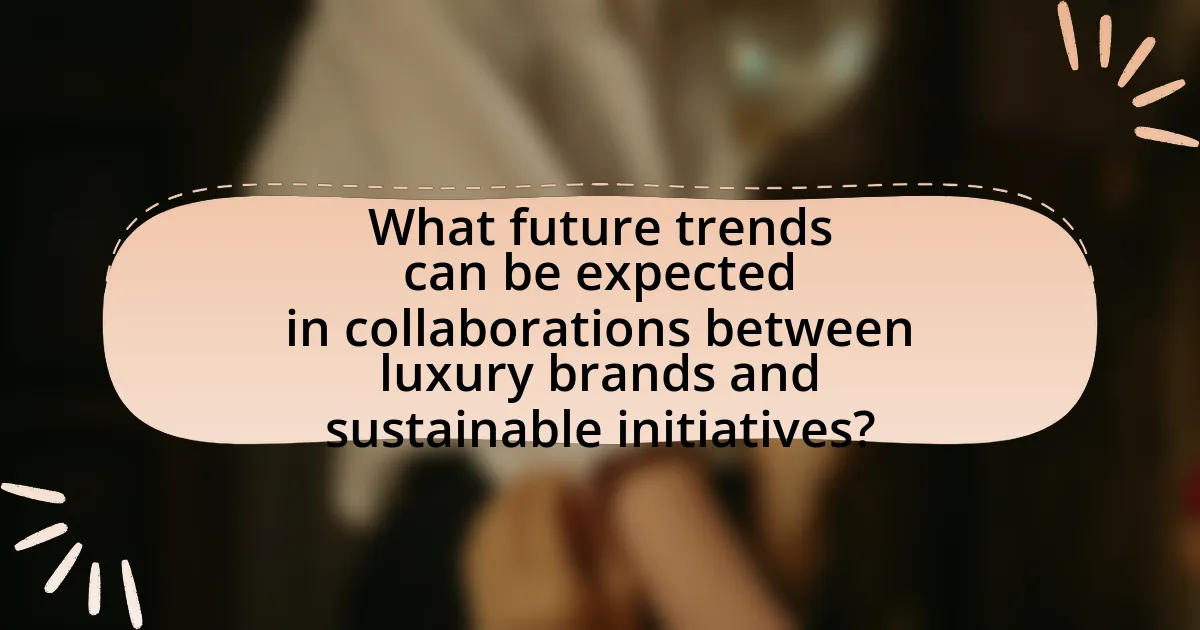
What future trends can be expected in collaborations between luxury brands and sustainable initiatives?
Future trends in collaborations between luxury brands and sustainable initiatives will increasingly focus on transparency, circular economy practices, and innovative materials. Luxury brands are expected to adopt greater transparency in their supply chains, allowing consumers to trace the origins of products and understand their environmental impact. Additionally, the circular economy will gain traction, with brands implementing take-back programs and designing products for longevity and recyclability. Innovative materials, such as bio-based textiles and recycled materials, will become more prevalent as luxury brands seek to reduce their carbon footprint and appeal to environmentally conscious consumers. These trends are supported by a growing consumer demand for sustainability, with a 2021 McKinsey report indicating that 67% of consumers consider sustainability when making luxury purchases.
How is technology influencing these collaborations?
Technology is significantly influencing collaborations between luxury brands and sustainable initiatives by enabling efficient communication, data sharing, and innovative solutions. Digital platforms facilitate real-time collaboration, allowing brands to engage with sustainability experts and organizations seamlessly. For instance, blockchain technology enhances transparency in supply chains, ensuring that luxury brands can verify the sustainability of their materials and practices. Additionally, data analytics tools help brands assess their environmental impact and track progress towards sustainability goals, fostering accountability and informed decision-making. These technological advancements not only streamline collaboration but also enhance the credibility and effectiveness of sustainability initiatives within the luxury sector.
What role does innovation play in enhancing sustainability efforts?
Innovation is crucial in enhancing sustainability efforts by introducing new technologies and practices that reduce environmental impact. For instance, advancements in materials science have led to the development of biodegradable fabrics and sustainable sourcing methods, which luxury brands are increasingly adopting. According to a report by McKinsey & Company, 67% of luxury consumers are willing to pay more for sustainable products, indicating that innovation not only drives sustainability but also meets consumer demand. Furthermore, innovative processes such as circular economy models enable brands to minimize waste and extend product life cycles, thereby contributing to overall sustainability goals.
How are consumer expectations shaping future collaborations?
Consumer expectations are driving luxury brands to prioritize sustainability in future collaborations. As consumers increasingly demand transparency and ethical practices, luxury brands are responding by partnering with sustainable initiatives to enhance their brand image and meet these expectations. For instance, a 2021 McKinsey report indicated that 67% of consumers consider sustainability when making luxury purchases, prompting brands to align their strategies with these values. This shift not only reflects consumer preferences but also influences the types of partnerships luxury brands pursue, focusing on eco-friendly materials and ethical production methods to satisfy the growing demand for responsible consumption.
What best practices can luxury brands adopt for effective collaborations?
Luxury brands can adopt several best practices for effective collaborations, including aligning values with partners, ensuring clear communication, and establishing measurable goals. Aligning values is crucial as it fosters authenticity and resonates with consumers; for instance, brands like Stella McCartney have successfully collaborated with sustainable initiatives that reflect their commitment to environmental responsibility. Clear communication between partners helps to streamline processes and avoid misunderstandings, which is essential for maintaining brand integrity and project timelines. Establishing measurable goals allows luxury brands to assess the impact of their collaborations, as seen in partnerships like Gucci’s collaboration with The RealReal, which aimed to promote circular fashion and track sustainability metrics. These practices enhance the effectiveness of collaborations and contribute to the overall success of luxury brands in the sustainable landscape.
How can brands ensure alignment of values with their partners?
Brands can ensure alignment of values with their partners by conducting thorough due diligence and establishing clear communication channels. This involves assessing potential partners’ missions, practices, and reputations to confirm they share similar ethical standards and sustainability goals. For instance, a study by the Harvard Business Review highlights that successful collaborations often stem from shared values, which can enhance brand reputation and customer loyalty. By implementing regular evaluations and open discussions, brands can maintain alignment and adapt to any shifts in values over time.
What strategies can enhance transparency and accountability in collaborations?
Implementing clear communication protocols enhances transparency and accountability in collaborations. Establishing regular updates and feedback loops ensures all parties are informed about progress and challenges, fostering trust. Additionally, utilizing third-party audits can provide objective assessments of collaboration outcomes, as seen in partnerships like the one between Stella McCartney and the Ellen MacArthur Foundation, which emphasizes sustainability metrics. Furthermore, creating shared goals and measurable objectives allows for accountability, as demonstrated by the Fashion Pact, where member brands commit to specific environmental targets. These strategies collectively promote a culture of openness and responsibility in collaborative efforts.
